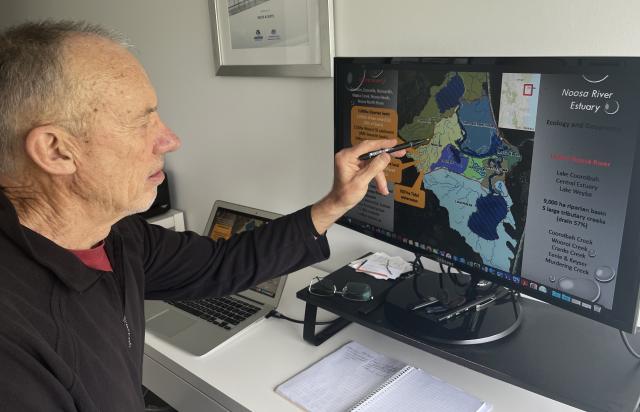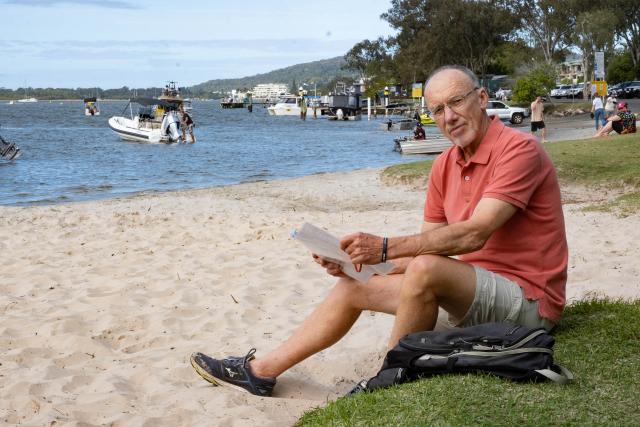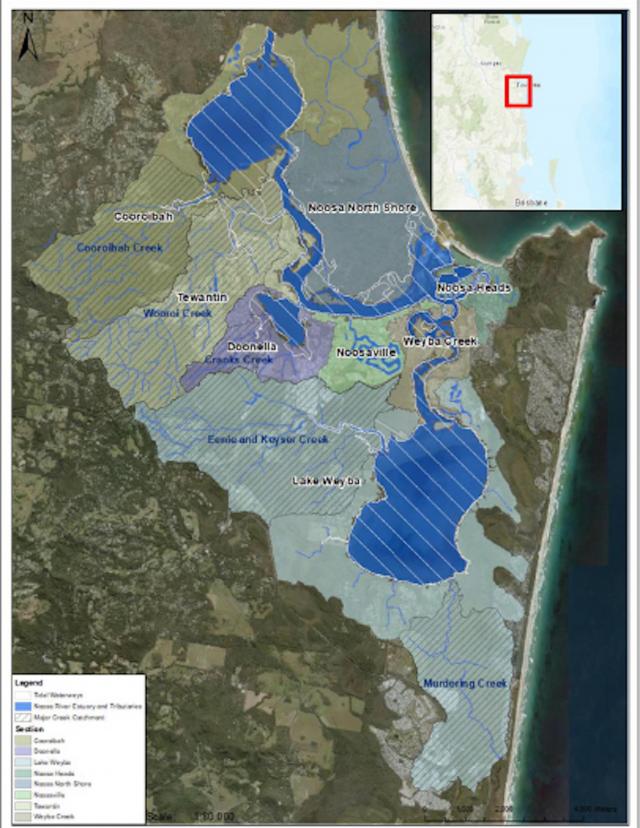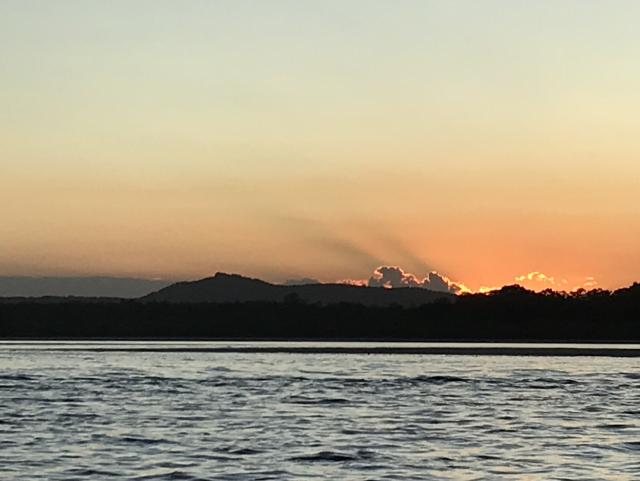PHIL JARRATT examines the conclusions and recommendations of the recent Noosa Wetlands independent report
It’s been a few weeks since we first met to discuss Peter Hunnam and Alex Western’s Wetlands In Noosa River Estuary report, but Peter, a 73-year-old retired ecologist, has lost none of his infectious energy and enthusiasm for making stuff happen.
If I’d thought the fact that Noosa Today and large sections of the community have actually been taking notice of this eminently sensible report might have given him license to sit back and relax for a bit, that fantasy went out the window (literally) when we met again last weekend, overlooking said river on a bleak and blustery day, to go over the report’s findings and recommendations and paint a picture of what the future could look like.
Peter paced the room while ideas tumbled from his lips, but it soon became obvious that while he sees myriad problems, he also sees the opportunity to restore our river to a shining example of urban land use and environmental responsibility working hand in hand.
But it ain’t going to be easy.
Our previous report on the NICA-supported wetlands study (NT, 14 October) highlighted the enormous extent of the lower Noosa River and its catchment, with over 9000 hectares of foreshore and riparian wetlands along 66 kilometres of river and estuary, and the numerous pressure points within that space. Now I’ve asked to hear about possible solutions to the problems created by half a century of increasing urban development.
Says Peter: “I’d like to see better care taken of the Noosa River and especially its fragile edges – the shore, shallows and foreshore. Everyone in Noosa lives close to a wetland and so is every school, but we are often not aware of them, and do not value them sufficiently as a vital part of the river and estuary ecosystem. We need more soft engineering, more planting, more access for recreation and enjoyment of the natural river and foreshore habitats, ecology and biodiversity.”
He continues: “The foreshore is a highly valuable public asset, but in the intensively used estuary we have let too much of it get abused and damaged, too many concrete structures and surfacing. We have also allowed too much private ownership and development, hundreds of properties that back onto tidal wetland areas, hundreds of private jetties and pontoons and very few public ones.
“Few if any of these are designed and managed with regard to the ecology of the site they are built on or next to.
“I’d love to see a major effort put into a restoration program, involving the whole of the community and the whole of Noosa Council – not just environmental services, but the roads, storm drains and recreational parks divisions who are really responsible for using and managing sustainably most of the estuary foreshore.
“We need a major clean-up of many of the hard structures and surfaces that litter the shorelines. These destroy rather than conserve the ecological processes on which the health of our river depends.
“Less junk, less parking, less rock wall, less run-off, ground and water pollution, erosion, less private infrastructure, less anchor and wake damage to fragile shores and shallows, seagrass and mangrove habitats.”
There is a lot to swallow in all of that, but Peter, who spent much of his 50-year career as an ecologist and environmental scientist managing sensitive ecosystems, including several other biosphere reserves, is a staunch advocate of enlisting community and environmental groups support in pointing out the mapped pressure points and fixing them now, rather than waiting for an over-arching river management plan to fall out of the sky.
He calls it a “reverse restoration strategy”.
“The pressure points for the river are widespread but by no means uniform, so often the authorities will look at the good bits and protect them, whereas I think we should tackle the problems head-on.
“Now, with our mayor on the Olympics committee, we have the perfect opportunity to launch a decade-long community initiative to restore the river system to what it should and can be.”
The following are edited highlights of the conclusions, recommendations community engagement, impacts and overall vision of the Wetlands Urban Land Use Pressures report.
Conclusions
An overall conclusion is that with significant and extensive pressures, the natural values of Noosa estuary are not sustainable without improved management and conservation measures.
There is no strategy or system in place for protecting the estuary, its foreshore and riparian wetlands or any other habitat. There are no effective estuarine or wetland reserve areas.
Current measures to conserve natural habitats in the estuary precinct are limited to a few designated reserve areas that do not provide adequate protection from nearby urban land use or waterway use.
The underlying problem is that urban land-use, public and private buildings and associated infrastructure have been developed closely and extensively around the central estuary precinct with inadequate regard for the healthy functioning of the estuary ecosystem.
Major problems include:
• There has been excessive clearing and destruction of foreshore habitats by development directly on foreshore land and the littoral zone – buildings, roads, other infrastructure and urban parks, as well as more than 1000 hard structures of “waterway infrastructure” (jetties, boat ramps, stormwater outfalls etc).
• Most other stretches of Noosa’s foreshore wetlands have been significantly degraded by development of urban land-use in close proximity – resulting in extensive “edge effects” of encroachment and increased inputs of foreign materials (litter, pollutants and waste dumping to weeds and domestic pests).
• The run-off and contaminants from every building, road and other hard surface in urban Noosa (over 1400 ha) is channelled through the stormwater drainage system into the estuary (via over 200 unmodified outfalls) causing significant disruption to the ecological functions of foreshore and riparian wetlands and the estuary as a whole.
Recommendations
It is hoped that the assessment of urban development pressures on the lower Noosa River system will be useful to the current initiative by Noosa Council, State Government agencies and community representatives on the Noosa River Stakeholders Advisory Committee to strengthen collaborative management and conservation of the whole Noosa River and catchment system. The aim would be to bring together all agencies with responsibilities for managing different components and use activities across the whole river system, to collaborate on planning and putting in place a comprehensive, integrated and long-term management system and program.
For the Noosa estuary the most effective dual strategy for conservation and sustainability would be to address directly the main ecological problems caused by urban land-uses, plus
a complementary strategy to systematically restore and enhance the ecological functions and natural amenity of areas that are degraded.
Possible mechanisms to mitigate urban land-use pressures on the estuary include:
• For structures and surfaces built directly on foreshore land, engage owners and managers in a systematic program to reduce their impacts on the ecology of those sites and surrounding areas.
• Renovation or new structure development directly on foreshore land, maximising the application of ecological principles in design, materials, construction, operation and ultimate removal and site restoration.
• New and renovated roadways and road drainage throughout Noosa estuary and basin: modify design to minimise impacts of run-off and maximise wetland functionality.
• Foreshore and riparian recreation parkland: re-design and modify to restore and enhance ecological processes, biodiversity and natural amenity.
Living Foreshores Strategy: priority sites for management attention
The survey identified several degraded stretches of the estuary foreshore as priorities for restoration and enhancement, pilot sites for a Living Foreshores strategy involving Noosa Council in partnership with local community conservation volunteers.
Community engagement
The Wetlands project originated from long-running local community conservation activities relating to the lower Noosa River, including riparian bush-care, litter and rubbish clean-ups, and monitoring projects – water quality, habitats, wildlife populations. These are supported through a range of community organisations: Noosa Integrated Catchment Association, OzFish Noosa, North Tewantin BushCare Group, CleanUp Australia Day, Noosa Parks Association, Noosa Community Biosphere Association.
A basic aim of the project is to support and strengthen these river and estuary conservation activities, and the findings of the project are starting to be used towards this objective.
An underlying challenge is the lack of a coherent mechanism for forming a clear collective vision and suitable management system and programs for conserving and sustaining the Noosa River or estuary.
Impacts
In practise, very little urban or tourism development is planned or implemented with adequate regard for the ecological functioning of the land or water on which the development is based.
In particular many rivers, estuaries and wetlands attract waterside urban communities that are developed and managed poorly. Their natural values, ecological health and resilience are progressively degraded rather than safeguarded and sustained.
Many UNESCO biosphere reserves are faced with the same types of problems found in Noosa, and would benefit from taking the approach promoted by the Wetlands project – of governing the human uses of the ecosystem within carefully defined sustainable limits.
Vision
Although the Wetlands project is only a very small initiative, it is hoped that the findings will help catalyse a stronger and more effective system for management and conservation of the Noosa River, one that sustains the river and catchment as the living heart of the Noosa Biosphere Reserve.
Our vision is for Noosa River Biosphere Reserve to be an exemplar of world best practices in ecologically-sustainable urban and tourism development in a healthy biodiverse coastal river ecosystem.










